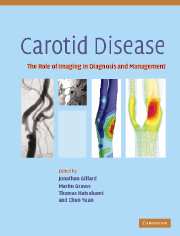Book contents
- Frontmatter
- Contents
- List of contributors
- List of abbreviations
- Introduction
- Background
- 1 Pathology of carotid artery atherosclerotic disease
- 2 Epidemiology of carotid artery atherosclerosis
- 3 Genetics of carotid atherosclerosis
- 4 Hematological processes in emboli formation
- 5 Medical treatment for carotid stenosis
- 6 Surgical management of symptomatic carotid disease: carotid endarterectomy and extracranial-intracranial bypass
- 7 Surgery for asymptomatic carotid stenosis
- 8 Interventional management of carotid disease
- Luminal imaging techniques
- Morphological plaque imaging
- Functional plaque imaging
- Plaque modelling
- Monitoring the local and distal effects of carotid interventions
- Monitoring pharmaceutical interventions
- Future directions in carotid plaque imaging
- Index
- References
1 - Pathology of carotid artery atherosclerotic disease
from Background
Published online by Cambridge University Press: 03 December 2009
- Frontmatter
- Contents
- List of contributors
- List of abbreviations
- Introduction
- Background
- 1 Pathology of carotid artery atherosclerotic disease
- 2 Epidemiology of carotid artery atherosclerosis
- 3 Genetics of carotid atherosclerosis
- 4 Hematological processes in emboli formation
- 5 Medical treatment for carotid stenosis
- 6 Surgical management of symptomatic carotid disease: carotid endarterectomy and extracranial-intracranial bypass
- 7 Surgery for asymptomatic carotid stenosis
- 8 Interventional management of carotid disease
- Luminal imaging techniques
- Morphological plaque imaging
- Functional plaque imaging
- Plaque modelling
- Monitoring the local and distal effects of carotid interventions
- Monitoring pharmaceutical interventions
- Future directions in carotid plaque imaging
- Index
- References
Summary
Introduction
Stroke is the third leading cause of death in the United States, accounting for 600 000 cases each year, of which about 500 000 are first attacks (American Heart Association, 2001; Heart and Stroke Statistical Update. Dallas, TX, 2001). The pathologic events leading to stroke are complex, and involve atherosclerosis of the aorta and its branches, especially the carotid artery, obstruction of blood flow by increasing plaque burden, embolization of plaque components, especially of thrombotic material, and cerebrovascular factors. The importance of plaque components that predispose to plaque disruption, in addition to the degree of stenosis, has relatively recently been appreciated in relation to cerebral ischemic events. The purpose of this chapter is to characterize atherosclerotic carotid disease in light of our knowledge of coronary atherosclerosis and relate carotid plaque morphology to cerebral ischemic syndromes with special focus on features of plaque instability. A precise understanding of the histologic features of carotid atherosclerosis should help target specific treatments that are likely to be beneficial in the prevention of a subsequent event.
Pathologic features of atherosclerosis, lessons learned from aortic and coronary artery disease
The pathologic classification of atherosclerosis is in constant evolution, and should reflect in part variation based on the size of the artery involved. Two types of lesions were initially described based on gross examination of the aorta: the fatty streak and the atheromatous plaque. The fatty streak, as the less elevated and not prone to thrombosis, was considered a precursor lesion to the advanced atheromatous plaque.
- Type
- Chapter
- Information
- Carotid DiseaseThe Role of Imaging in Diagnosis and Management, pp. 1 - 21Publisher: Cambridge University PressPrint publication year: 2006
References
- 1
- Cited by



